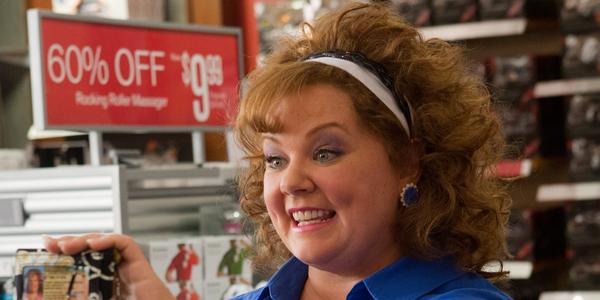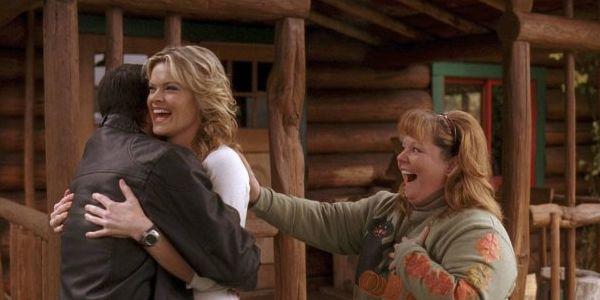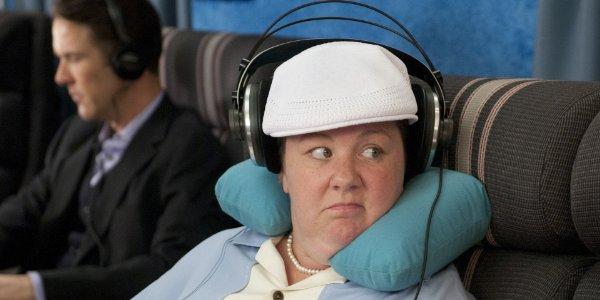What is there to say about Melissa McCarthy? She played fan favorite Sookie St. James on television’s Gilmore Girls and now is the lead in Mike and Molly for CBS. But McCarthy’s career on the silver screen tells us a different story. The actress didn’t get her big break in film until 2011, though she’s been around for quite some time.
But why is that? We can point to Hollywood’s tight restrictions on how women in film should look – don’t you love the “diversity” of women in Hollywood? This isn’t a dissertation on representation in Hollywood, but we can look at some of McCarthy’s previous roles and see how the actress has evolved throughout the years. It’s the perfect time to do so since Identity Thief, which hits theaters tomorrow, gives McCarthy her first-ever leading performance in a motion picture.
On that note, it’s a massive slight that the actress hasn’t been given too many opportunities to genuinely shine on the silver screen. For that reason we’re looking at her work in three films – one of which, you likely guessed, is Bridesmaids.
The Nines, which was released in 2007, sees McCarthy as a publicist, the wife of a video game developer, and herself in three different yet intertwining (and quite often overlapping) stories. It’s a worthwhile, yet somewhat flat effort on the whole, but its primary cast, led by Ryan Reynolds and also featuring Hope Davis, acquits itself well into the framework of the odd tales about a man who seems to be losing his mind. Despite the great work of her co-stars, McCarthy’s performance is what helps The Nines function more capably than it really should.
As she inhibits each of these characters she tackles each one in a different manner. That sounds like common sense certainly, but the actors’ performances connect to each of the characters they play throughout. It’s easy to play them all the same way or not differently enough, but making something unique and complex out of these characters who are so very much connected but not completely the same takes some work, and McCarthy isn’t one to back down from a challenge.
Davis plays each part with perhaps too many similarities, while Reynolds relies a bit too much on his different looks while playing the husband. But McCarthy doesn’t fall into this trap. As the publicist, she’s an overly perky and bubbly personality whose demeanor can bitingly turn on a dime. As the wife, she shows and doesn’t tell that her marriage is a happy one and that she genuinely worries for her husband as he’s away. As herself, she’s the energetic and humorous actress we know and love.
Pretty Ugly People, the mostly abysmal directorial debut of The Help's Tate Taylor, comes one year later in 2008. Friends reunite to help their obese friend, played by Missi Pyle, when they think she is close to her death. They come to find out she’s lost the weight and wants them to go hiking with her. Prety Ugly People struggles to find any one particular tone. Ranging from the outlandish, less than humorous comedy, to attempted drama that misses more often than it hits, it often inspires more laughs than the actual comedy.
In the midst of the crazy shifts in tone, People also fails to do much that’s interesting with its characters. Surviving the lack of tonal sense and empathy for characters however, is McCarthy. She nails her role as the high school friend whose past is a mystery to her husband who’s less than keen on keeping their relationship moving forward. (Then again, her past is a mystery to us as well, and the film’s presentation doesn’t suggest it’s supposed to be that way). McCarthy pulls out of an undeveloped script and is a character for which we can feel for without being confused as to why.

Finally, we arrive at Bridesmaids in 2011. It feels like just yesterday that the classic outing at the bridal shop sent me into a fit of tearful laughter. Unfortunately at the time, I was rather dismissive of McCarthy. It’s not so much that I maligned her performance though; it’s just that I gave it nowhere near its proper credit. From my original review:
“[W]e’ve got Melissa McCarthy. She’s the typical ‘comic relief’ character, one that can either sink or swim. Fortunately for us, she succeeds in bringing the crazy Megan to a hugely comedic life. McCarthy juxtaposes seemingly eccentric thoughts and ideals with an exuberantly happy-go-lucky attitude.”
It’s simple to pigeonhole McCarthy’s work in Bridesmaids as only “comic relief.” She’s certainly the funniest character in the film, but it’s not just her comedy that makes it work. It’s an innate knowledge of what will and will not work in film – particularly one as well-cast and surprisingly developed as Bridesmaids. In what comes closest to being a dramatic scene for McCarthy, she delivers the abridged story of her life to Kristen Wiig’s lead character, acting as a mentor-like figure. This portion of Bridesmaids would hardly work if McCarthy played the rest of the role too broadly and with too little abandon. Instead she wrings the most laughter and heart out of this role by playing it close to the chest and not to the rafters. It looks rather simple but McCarthy takes the trope of the common-relief character to another level.
With Identity Thief heading our way, McCarthy gets her first leading role in a motion picture. The summer will bring The Heat, which she co-leads with Sandra Bullock, and she and husband Ben Falcone just recently set up three new films. In just two years, McCarthy graduated from a more-than-dependable supporting actress to a leading lady. And it’s about time it happened because Melissa McCarthy isn’t an actress whose talents should only be used to build up other actors. Her newfound success is more than deserved; it’s due.